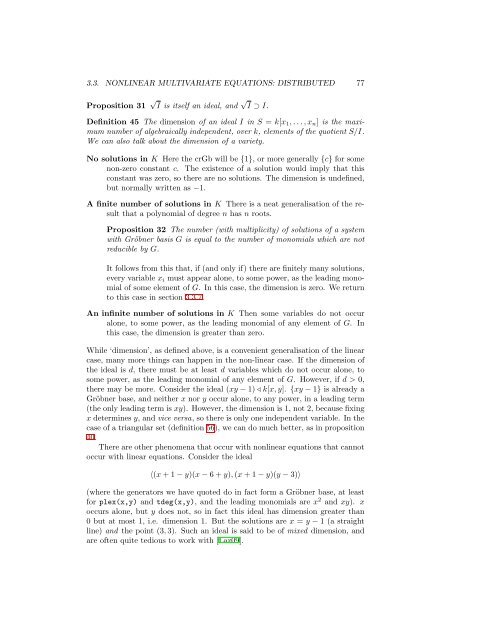Contents - Student subdomain for University of Bath
Contents - Student subdomain for University of Bath
Contents - Student subdomain for University of Bath
You also want an ePaper? Increase the reach of your titles
YUMPU automatically turns print PDFs into web optimized ePapers that Google loves.
3.3. NONLINEAR MULTIVARIATE EQUATIONS: DISTRIBUTED 77<br />
Proposition 31 √ I is itself an ideal, and √ I ⊃ I.<br />
Definition 45 The dimension <strong>of</strong> an ideal I in S = k[x 1 , . . . , x n ] is the maximum<br />
number <strong>of</strong> algebraically independent, over k, elements <strong>of</strong> the quotient S/I.<br />
We can also talk about the dimension <strong>of</strong> a variety.<br />
No solutions in K Here the crGb will be {1}, or more generally {c} <strong>for</strong> some<br />
non-zero constant c. The existence <strong>of</strong> a solution would imply that this<br />
constant was zero, so there are no solutions. The dimension is undefined,<br />
but normally written as −1.<br />
A finite number <strong>of</strong> solutions in K There is a neat generalisation <strong>of</strong> the result<br />
that a polynomial <strong>of</strong> degree n has n roots.<br />
Proposition 32 The number (with multiplicity) <strong>of</strong> solutions <strong>of</strong> a system<br />
with Gröbner basis G is equal to the number <strong>of</strong> monomials which are not<br />
reducible by G.<br />
It follows from this that, if (and only if) there are finitely many solutions,<br />
every variable x i must appear alone, to some power, as the leading monomial<br />
<strong>of</strong> some element <strong>of</strong> G. In this case, the dimension is zero. We return<br />
to this case in section 3.3.7.<br />
An infinite number <strong>of</strong> solutions in K Then some variables do not occur<br />
alone, to some power, as the leading monomial <strong>of</strong> any element <strong>of</strong> G. In<br />
this case, the dimension is greater than zero.<br />
While ‘dimension’, as defined above, is a convenient generalisation <strong>of</strong> the linear<br />
case, many more things can happen in the non-linear case. If the dimension <strong>of</strong><br />
the ideal is d, there must be at least d variables which do not occur alone, to<br />
some power, as the leading monomial <strong>of</strong> any element <strong>of</strong> G. However, if d > 0,<br />
there may be more. Consider the ideal (xy − 1) ⊳ k[x, y]. {xy − 1} is already a<br />
Gröbner base, and neither x nor y occur alone, to any power, in a leading term<br />
(the only leading term is xy). However, the dimension is 1, not 2, because fixing<br />
x determines y, and vice versa, so there is only one independent variable. In the<br />
case <strong>of</strong> a triangular set (definition 56), we can do much better, as in proposition<br />
40.<br />
There are other phenomena that occur with nonlinear equations that cannot<br />
occur with linear equations. Consider the ideal<br />
〈(x + 1 − y)(x − 6 + y), (x + 1 − y)(y − 3)〉<br />
(where the generators we have quoted do in fact <strong>for</strong>m a Gröbner base, at least<br />
<strong>for</strong> plex(x,y) and tdeg(x,y), and the leading monomials are x 2 and xy). x<br />
occurs alone, but y does not, so in fact this ideal has dimension greater than<br />
0 but at most 1, i.e. dimension 1. But the solutions are x = y − 1 (a straight<br />
line) and the point (3, 3). Such an ideal is said to be <strong>of</strong> mixed dimension, and<br />
are <strong>of</strong>ten quite tedious to work with [Laz09].












![[Luyben] Process Mod.. - Student subdomain for University of Bath](https://img.yumpu.com/26471077/1/171x260/luyben-process-mod-student-subdomain-for-university-of-bath.jpg?quality=85)



